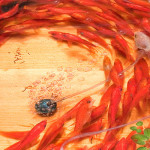

To replicate that in captivity, you need to adjust temperatures accordingly. Therefore, breeding for goldfish is triggered by a change in temperature, from the cold winter season to the warmer spring. In the wild, goldfish breed in the warm season, spring. You also need to set up a different tank where the fry will be kept once they are hatched. Or for information on what to feed your goldfish, check out our wide range of goldfish food.Before beginning your goldfish breeding journey, you must first make sure your main tank is well set with a filtration system, plants, especially live plants such as hornwort, a heater and a spawning mop.Ī spawning mop is not only recommended because it helps to protect the eggs from their parents, but also, it makes it easy to move the fry into a separate tank once they are hatched.Īpart from setting up the main tank. Thinking of setting up your own goldfish tank? Then head over to our guide on Setting Up Your First Goldfish Tank.įor more information on the many varieties of Goldfish available, see our Goldfish page. Ranchu have a higher curved back than Lionheads. The scales are metallic and come in a wide variety of colours from white to black. Ranchu goldfish are quite distinct as they lack any dorsal fin. Believed to have been bred in the 19 th century, it looks cross eyed! Ranchu Goldfish With eyes mounted on the top of its head, the Celestial Eye goldfish gazes upwards towards the stars. Fantail GoldfishĪnother egg shape fish, these are bred with their long-split tail as their main feature, giving them two tails in one! Celestial Eye Goldfish Similar to the Fantail Goldfish except for its protruding telescope eyes and slightly smaller size.

A slow swimmer, it should be paired with other slow swimmers so it can feed! Telescope Eye GoldfishĪ Telescope Goldfish has an egg-shaped body with a double caudal fin. Lion Head GoldfishĪn egg shape, rounded fish without a dorsal fin, the Lionhead Goldfish was bred in China to develop a fleshy lion’s mane on top of its head. They make excellent pond fish and can even tolerate the cold months outside. Shubunkin goldfish are a hardy, single-tailed fish with different coloured markings. They are just as hardy as common goldfish and can be kept in ponds or aquariums. Very similar to common goldfish, these fish are smaller with much longer, deeper forked tails. These goldfish have bizarre looking bubbles underneath their eyes that can grow so big that they have trouble seeing! Their bubbles are very delicate and are notorious for getting stuck in the filter, so it helps to have a foam cover for the uptake valves. Metallic scales make them bronze when they’re young but black when they’re adults. However, to they’re so small you’d have to use a microscope to see them! Black Moor GoldfishĪn egg shape, the black Moor’s eyes protrude from the side of its head. Fun fact, you can tell how old a goldfish is by its scales, for every year of their life they develop rings called circuli. Types of Goldfish Common GoldfishĪ hardy, colourful, inexpensive fish, the common goldfish is one of the most popular pets. To make it easier for you tell the difference, we have put together a handy guide to some of the top Goldfish varieties. In fact, there are several varieties of goldfish out there to pick from! From the Black Moor and the Shubunkin, to the Chinese Lionhead and the Celestial Eye that dates back to the 19th century, we’ve got you covered. The common goldfish can be considered a staple in most British homes, but it’s not the only type of goldfish available.

Spare Parts For Fish Tanks and Aquariums.


 0 kommentar(er)
0 kommentar(er)
